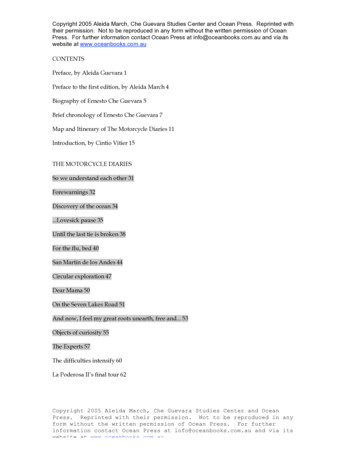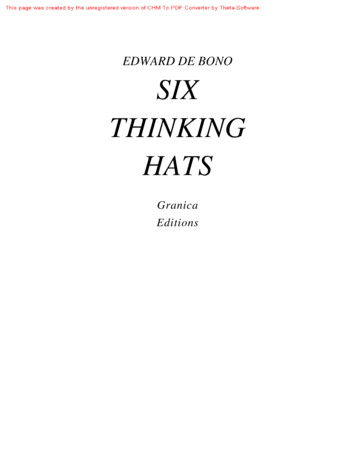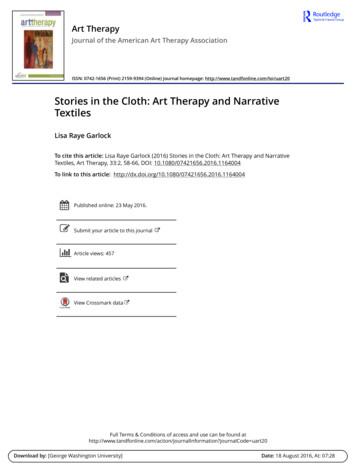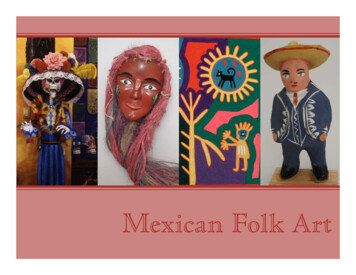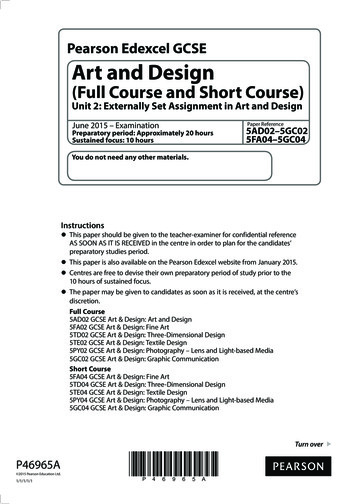
Transcription
Pearson Edexcel GCSEArt and Design(Full Course and Short Course)Unit 2: Externally Set Assignment in Art and DesignJune 2015 – ExaminationPreparatory period: Approximately 20 hoursSustained focus: 10 hoursPaper Reference5AD02–5GC025FA04–5GC04You do not need any other materials.Instructionspaper should be given to the teacher-examiner for confidential reference ThisAS SOON AS IT IS RECEIVED in the centre in order to plan for the candidates’ preparatory studies period.This paper is also available on the Pearson Edexcel website from January 2015.Centres are free to devise their own preparatory period of study prior to the10 hours of sustained focus.The paper may be given to candidates as soon as it is received, at the centre’sdiscretion.Full Course5AD02 GCSE Art & Design: Art and Design5FA02 GCSE Art & Design: Fine Art5TD02 GCSE Art & Design: Three-Dimensional Design5TE02 GCSE Art & Design: Textile Design5PY02 GCSE Art & Design: Photography – Lens and Light-based Media5GC02 GCSE Art & Design: Graphic CommunicationShort Course5FA04 GCSE Art & Design: Fine Art5TD04 GCSE Art & Design: Three-Dimensional Design5TE04 GCSE Art & Design: Textile Design5PY04 GCSE Art & Design: Photography – Lens and Light-based Media5GC04 GCSE Art & Design: Graphic CommunicationTurn overP46965A 2015 Pearson Education Ltd.1/1/1/1/1*P46965A*
Candidate guidanceYour teacher will be able to teach, guide and support you as you prepare your personalresponse. You may also complete preparatory work without direct supervision.The preparatory periodThe process of producing work for assessment may begin once you receive this paper.You should develop your response to the theme in a personal, creative way.The preparatory period consists of approximately 20 hours. You should be producingsupporting studies, developing, refining and recording your ideas towards the finaloutcome(s).The period of sustained focusThe period of sustained focus consists of no more than ten hours working undersupervised examination conditions, in an appropriate studio setting, producing your finaloutcome(s) in response to the theme.During this time you should refer to your supporting studies and develop, refine andimprove your final outcome(s).Teachers will be able to support you with matters such as working space, materials andequipment. However, teachers will not be able to give you feedback about your work inprogress or suggest how you might improve or develop your outcome(s).The Externally Set Assignment is worth 40% of the GCSE.Your teacher will inform you of the dates and times when you will complete your tenhours of unaided work for the Externally Set Assignment.2P46965A
Exploring and Developing the ThemeThe theme this year is:Apart and/or TogetherCombined – meet – side by side – juxtaposed – closely – jointly – united – en masse –collectively – in cooperation – as one – separated – disconnected – independent – isolated –alone – individually – free – excluded – divorcedDiscuss the theme with your teacher and make sure that you produce evidence to coverthe four Assessment Objectives. Remember that each Assessment Objective is worth 25%of your final mark for this paper.The four Assessment Objectives are: develop ideas through investigations informed by contextual and other sources,demonstrating analytical and cultural understanding refine ideas through experimenting and selecting appropriate resources, media,materials, techniques and processes record ideas, observations and insights relevant to intentions in visual and/or otherforms present a personal, informed and meaningful response demonstrating analyticaland critical understanding, realising intentions and, where appropriate, makingconnections between visual, written, oral or other elements.Your work could develop from experimenting with materials and then move on torecording observations.You could start by recording observations in a variety of ways.You could begin to develop your response to the theme by investigating and analysingthe work of artists, designers and craftworkers and then move on to recordingobservations or experimenting with materials and techniques.Evidence for the Assessment Objectives may be produced in a variety of ways.Suggested Starting Points and Contextual ReferencesThe starting points and contextual references on the following pages are suggestions tohelp you think about possible ideas, preferred ways of working and a personal creativeapproach to this year’s theme.You may prefer to use a starting point of your own and explore and respond to otherartists, images, websites, apps and publications that relate to the theme ‘Apart and/orTogether’.P46965A3Turn over
Apart and/or TogetherPeopleThe simple act of embracing or kissing has been portrayed by many artists. One of themost celebrated depictions is Gustav Klimt’s painting The Kiss. The painting is full ofsymbolism and is highly decorated with paint effects, geometric patterns and flowers.Could this painting, or a similar source, provide you with inspiration for your response?People coming together to celebrate a wedding, birthday or other special occasion mightpresent you with a way of investigating the theme.Movements of the body fascinate artists and designers and are the source of inspirationfor many works of art. Gymnasts, acrobats, bodybuilders and dancers extend andcompress their limbs in order to create interesting shapes. Could you explore and recordbody movement to develop your response?Observing people as they gather, assemble, congregate or queue might provide you withan interesting starting point for your work.The plight of refugees from war torn countries are often in the news. MuhammedMuheisen’s photograph shows a young Afghan Refugee Girl. Many refugees experienceloneliness and separation; these are issues a number of artists and designers haveinvestigated. Could you use similar starting points for your response?Gustav KlimtThe Kisspainting4P46965A
Muhammed MuheisenAfghan Refugee GirlphotographContextual ReferencesSandro Botticelli (Fine Art)Alban Grosdidier (Photography – Lens and Light-based Media)Annette Collinge (Textile Design)Auguste Rodin (Three-Dimensional Design)Milton Glaser (Graphic mistrygallery.co.ukArt: The Definitive Visual Guide: Dorling KindersleyThe Photography Book: PhaidonTextiles Now: Laurence King PublishingPostcards from Vogue: 100 Iconic Covers (Paperback): Particular BooksKlimt: TaschenThe references on these pages could help you to think about possible ideas and couldbe used to support any starting point. You may prefer to explore and respond to otherartists, images, websites, apps and publications.P46965A5Turn over
Apart and/or TogetherPlacesCombining image and text is a powerful way to communicate a message to an audience.Paula Scher, in her painting Map of Africa, transforms the appearance of a map of Africawith a mass of information using a combination of words and pictures. Could you explorethe creative possibilities of bringing together image and text to develop your response?New and old buildings, built with modern and traditional materials, may combine tocreate a mixture of colours, patterns and shapes. Could you use these sources as astarting point to make imagery and artefacts of your own?Bridges, subways and tunnels join places together and can have both decorative andfunctional qualities. Could their design features and the way they connect areas togetheroffer you a way to explore the theme?Valleys, waterways, gorges, embankments, roads and railways can separate and connectdifferent parts of the landscape. Observing and recording such places might provide youwith an interesting starting point.The painting Nighthawks by Edward Hopper depicts an almost empty café and adeserted street, expressing a desolate mood of solitude and detachment. Railwaystations, restaurants, airports, schools and shopping centres are usually busy and noisyplaces. Late at night and early in the morning these places are often deserted, creating astrange and empty atmosphere. Could you research similar sources and ideas to inspireyour response?Paula ScherMap of Africapainting6P46965A
Edward HopperNighthawkspaintingContextual ReferencesEdward Burra (Fine Art)Christophe Jacrot (Photography – Lens and Light-based Media)Sandra Meech (Textile Design)Grayson Perry (Three-Dimensional Design)David Carson (Graphic Communication)Harry Beck mwww.nationalmediamuseum.org.ukAnthony Caro: A life in Sculpture: Merrell1,000 Artisan Textiles: Contemporary Fiber Art, Quilts and Wearables: Quarry BooksThrough the Lens: National Geographic’s Greatest Photographs by National GeographicAt the Edge of Art: Thames and HudsonHopper: TaschenThe references on these pages could help you to think about possible ideas and couldbe used to support any starting point. You may prefer to explore and respond to otherartists, images, websites, apps and publications.P46965A7Turn over
Apart and/or TogetherNatural WorldShapes and patterns in the natural world can be a source of inspiration for artists anddesigners. In the photograph Chambered Nautilus by Edward Weston, the dominantfeature is the spiralling form twisting apart. Could you investigate forms in the naturalworld to inspire your outcome?The changing seasons bring about events such as animals emerging from hibernation inspring, falling leaves in the autumn or severe storms and high tides in winter. Sometimesthese events combine to create amazing scenes of colour and drama, which mightprovide you with an interesting starting point for your work.The beginning and end of life are expressed in art and design in many ways. Could birthor death observed in the natural world be a source of inspiration for your response?Exploring the visual impact of land or buildings broken apart by extreme weather,erosion, decay or other natural forces could help you to develop your ideas.Peter Markham Scott’s painting Nenes on Mauna Loa, Hawaii depicts a flock of geese inflight. The positioning of the geese in the painting creates a dramatic composition. Couldvisual research and recording of groups of living things provide you with ideas for yourresponse?Edward WestonChambered Nautilusphotograph8P46965A
Peter Markham ScottNenes on Mauna Loa, HawaiipaintingContextual ReferencesDavid Hockney (Fine Art)Alison Brady (Photography – Lens and Light-based Media)Elisabeth Frink (Three-Dimensional Design)Samantha Harvey (Textile Design)Prudence Mapstone (Textile w.nopattern.comwww.dadart.comwww.vinmag.comThe Photographer’s Eye: MOMA20th Century Photography: TaschenThe Story of Painting: Dorling KindersleyWood. Andy Goldsworthy: Thames and HudsonEdward Weston: J. Paul Getty MuseumThe references on these pages could help you to think about possible ideas and couldbe used to support any starting point. You may prefer to explore and respond to otherartists, images, websites, apps and publications.P46965A9Turn over
Apart and/or TogetherObjectsAssemblage artists create three-dimensional forms by combining discarded objects andscrap materials in boxes, free-standing constructions or installations. Louise Nevelsonused found objects, scraps of wood and architectural mouldings to create the sculptureDawn’s Wedding Chapel II. Could researching similar artists and experimenting with foundobjects help you develop your response?Investigating and recording the internal mechanisms and separate components ofobjects such as radios, televisions, washing machines, computers and clocks could offeryou an interesting starting point.Designers are often faced with the challenge of creating objects that can be taken aparteasily and put back together for storage or packaging purposes, for example flat-packfurniture. Could exploring this kind of design problem help you develop your response tothe theme?Crockery and cutlery are usually arranged together set out on a table. Other objectscome in pairs such as footwear, earrings and gloves. Could exploring objects that arecommonly seen together or in sets provide you with an interesting starting point for yourwork?Crushing, stretching and exploding objects are sometimes employed by artists anddesigners to create works of art. In Tambourinefrappe, John Chamberlain crushed andtwisted parts of vehicles together to create abstract sculpture. Could researching similarcontextual sources and exploring unusual ways of working provide you with inspiration?Louise NevelsonDawn’s Wedding Chapel IIassemblage10P46965A
John ChamberlainTambourinefrappesculptureContextual ReferencesPaul Cézanne (Fine Art)Andreas Gursky (Photography – Lens and Light-based Media)Michael Brennand-Wood (Textile Design)Joseph Cornell (Three-Dimensional Design)Susan Kare (Graphic comwww.whitney.orgThe Art of Assemblage: Museum of Modern Art, New YorkThe Found Object in Textile Art: Batsford500 Ceramic Sculptures: Contemporary Practice, Singular Works (500 Series): Lark BooksA Century of Graphic Design: Mitchell BeazleyThe Art Book: PhaidonModern British Sculpture: Royal Academy of ArtsThe references on these pages could help you to think about possible ideas and couldbe used to support any starting point. You may prefer to explore and respond to otherartists, images, websites, apps and publications.P46965A11Turn over
Apart and/or TogetherActivitiesAbdoulaye Konaté in his contemporary textile piece Génération biometrique n.5 bringstogether crafts of his cultural heritage such as appliqué, patchwork, and embroidery toexplore immigration issues.You might consider researching your own contextual sourcesand experimenting with traditional techniques to express ideas regarding issues thataffect you.Individuals can unite to bring about change or resistance. Could the activities ofcampaigning or protesting inspire ideas for your response?Stitching, sticking, fixing and folding are all actions that bring materials together.Conversely, ripping, tearing, cutting and dismantling are all actions that involveseparating or taking something apart. Could you explore these activities to develop ideasfor your work?The act of lifting your foot away from sand, mud or snow can leave an imprint. Pressingan object into a surface can leave an interesting mark or texture. This process has beenused and continues to be used by artists. Could experimenting with this idea help youdevelop a response?The beautifully crafted War Horse puppet created by Basil Jones and Adrian Kohlerbrings together human beings and sculptural forms. The War Horse puppets areoutstanding examples of how art and performance combine to animate and tell a story.The designers spent considerable time observing and sketching horses before creatingtheir puppets. Could researching design for the theatre or cinema provide you with aninteresting starting point?Abdoulaye KonateGénération biometrique n.5textile12P46965A
Basil Jones and Adrian KohlerWar HorsepuppetContextual ReferencesSalgado Sebãstiao (Photography – Lens and Light-based Media)Kara Walker (Fine Art)Louise Bourgeois (Three-Dimensional Design)Alan Aldridge (Graphic Communication)Julia Burrowes (Textile onweek.co.uk/designers.aspxwww.henry-moore.orgArt Now: TaschenPhotography: The 50 Most Influential Photographers of All Time (Icons of Culture):Barron’s Educational SeriesTravel Posters: PhaidonClothes for Heroes: The Punk Fashions of Vivienne Westwood and Malcolm McLaren:AbramsThe references on these pages could help you to think about possible ideas and couldbe used to support any starting point. You may prefer to explore and respond to otherartists, images, websites, apps and publications.P46965A13Turn over
Apart and/or TogetherImaginationSome artists investigate the use of colour to create bold and dramatic visual effects.Bridget Riley’s painting Achaean shows the juxtaposition of vertical parallel stripes ofcolour to create a powerful image. You might consider researching other contextualsources and exploring your own colour combinations as a starting point for imaginativework.Being alone and apart from your friends and family for long periods of time may be afrightening thought for some people. Imagine being isolated. How might you depict yourfeelings of being alone?Artists use perspective, scale, colour and other visual devices to make things appearcloser or further away, creating the illusion of depth on a flat surface. Could you explorethese elements and use them imaginatively to create depth in your work?Designers often bring together influences from different times and cultures to createnew and modern styles. Fashion designer Vivienne Westwood used elements of Scottishtartan combined with punk design to create modern and original costumes for theVienna State Ballet. You could research different approaches and styles from the historyof art and design and investigate ways of bringing them together to make new andoriginal work.Bridget RileyAchaeanpainting14P46965A
Vivienne WestwoodPunk costumes for ballerinas ofthe Vienna State Balletfashion designContextual ReferencesAnthony Green (Fine Art)Katherine Minott (Photography – Lens and Light-based Media)Lucy Brown (Textile Design)John Alvin (Graphic Communication)Jane Alexander (Three-Dimensional pture: From Antiquity to the Present Day: TaschenMeggs’ History of Graphic Design : John Wiley & Sons20th Century Ceramics: Thames and HudsonArt of the Digital Age: Thames and HudsonThe references on these pages could help you to think about possible ideas and couldbe used to support any starting point. You may prefer to explore and respond to otherartists, images, websites, apps and publications.P46965A15Turn over
General web comwww.art2day.co.ukwww.sculpture.org.ukGeneral appsLouvre HD: Evolution Games LLPArt History Flashcards: Virtual FlashcardsArt HD Great Artists Gallery and Quiz: ADS Software Group, IncThe Life of Art: J Paul Getty TrustCropped: A Brief History of Graphic Design: Cheryl PellSoviet Posters HD: Evolution Games LLPThe V&A: The Victoria and Albert MuseumWikipaintings Encyclopaedia of Fine Art: Katerina NerushNational Gallery London HD: Evolution Games LLPEvery effort has been made to contact copyright holders to obtain their permission for the use of copyrightmaterial. Pearson Education Ltd. will, if notified, be happy to rectify any errors or omissions and include any suchrectifications in future editions.16P46965A
The painting Nighthawks by Edward Hopper depicts an almost empty café and a deserted street, expressing a desolate mood of solitude and detachment. Railway stations, restaurants, airports, schools and shopping centres are usually busy and noisy places. Late at night and early i
